Dutch Museum Group Building Super Constellation Cockpit – December 31, 2009
I received an email from Tom Beudeker a couple of weeks ago informing me of an interesting project that was in progress on the small Dutch island of Texel. Tom, who is a flight engineer on the Aviodrome Constellation, recently ran into Ben Bieze, an old flight engineer colleague, who informed him that he and some friends were building a Super Constellation cockpit using instruments and components salvaged from the real thing. When completed, the cockpit will be put on display at Luchtvaart & Oorlogsmuseum (Air and War Museum) located at the small grass airfield in Texel. I contacted Ben and he provided photos and the following account of the project.
“As you know by now, we are building a cockpit of a Connie with parts from collected from different sources. Most of the parts are from Starliner N7315C (c/n 1017), which was scrapped at Anchorage International Airport in the mid-1990’s. The parts were sent to Schiphol Airport (Amsterdam) years ago by a Dutch flight engineer. The crew door, pedestal, part of the main instrument panel, glare shield panel, rudder pedals, part of the flight-engineer’s panels, nose wheel steering wheel, de-ice panel and a lot of small items are from the Starliner. There are also parts from KLM Connies that were scrapped at Schiphol Airport. Later, Gerard Reij (a ground engineer) bought all this items and started to repair parts and make new parts and panels. About ten years ago Jan Boon, the financial man from our museum and a great fan of Connies, became the owner of all the parts, which he stored in his house.”
 |
 |
 |
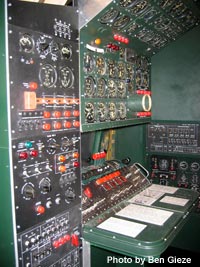 |
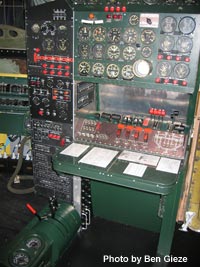 |
 |
Thanks very much to Tom and Ben for bringing this interesting story to my attention and providing photographs. I wish them luck with the project and look forward to posting photos of the finished cockpit.
MATS Connie Docent Shares His Experience – December 13, 2009
I received an email recently from Butch Whitmon, who had traveled with the MATS Connie as a docent back in September 1996. Butch had recently discovered my website and shared his experience flying with Captain Frank Lang on the MATS Connie. Although it’s not exactly “news”, I thought readers might enjoy Butch’s story.
 |
 |
 |
"Of course, one of the most interesting characters I've ever met is Captain Frank Lang. How fortunate I am to have spent several days working for him, sharing the experiences at Dupage, Tulsa and Ft Worth. I met people from all over the world during those days; people who shared our love of this beautiful aircraft. They shared their stories of their history with Connies with me or were eager to learn what I, as a docent, could tell them about the plane."
"After Dupage, we were sponsored into Tulsa by the local CAF chapter. We were greeted by the giddy members of that chapter, plus a local TV station crew who filmed (video) our landing and later interviewed Captain Lang and me (my fifteen minutes of fame). I did not know it at the time, but that interview aired on that evening's local news. The next day people touring the plane recognized me from the interview, resulting in an enlargement of my smile....and my head! One of my prized possessions is a copy of that video interview sent to me by the reporter doing the story on the MATS Connie's visit to Tulsa. Our morning departure for Ft Worth was delayed. The sponsor there said the spot on the ramp reserved for us was currently occupied by President Clinton's Air Force One. So, I did not get to see Air Force One, but I can say President Clinton delayed our take off from Tulsa."
"At Ft Worth I met a lady investigator for the NTSB. She was all business even while touring the plane even though she was not on official business. She was knowledgeable, interesting and obviously, tough as nails! I also met a couple from New Zealand who had been # 2 landing behind us at Ft Worth. They restored WW II bombers and other planes. They wanted to sponsor the Connie for an Air Show in New Zealand but, after discussing the cost with Capt. Lang, decided against it."
"Many students from an aviation school at Ft Worth were enthralled with the Connie. One in particular was in a dreamy state of non-belief, previously believing he'd never have a chance to see a Connie in real life. It's no stretch to say he was walking on Air.....Connies are among his favorite things on Earth."
"My tour with the MATS Connie and her crew is of course one of the most memorable experiences of my life. That beautiful work of art, for several days, elevated me out of my everyday job as railroad car inspector to "celebrity" docent and humble observer of a survivor of one of Aviation's most glorious eras and the talented, dedicated crew keeping her flying. I'm so glad to have found your website and thank you for it."
Butch Whitmon
Helena EC-121T Moved From UM-Helena to Airport Property - December 11, 2009
The Helena Independent Record reports on its website that EC-121T 52-3417 was moved on Thursday from University of Montana-Helena property to a spot next door at the Helena Regional Airport. The move was just 1/8 of a mile but represents the first step in getting the aircraft ready for a flight back to the Evergreen Aviation and Space Musuem in McMinnville, Oregon. The aircraft has been a fixture at the school since 1981, when it was flown in from Tucson, Arizona by a crew headed by former MATS Connie Captain Frank Lang. Thanks to Tim Brenden and Kevin Heide for giving me the heads up on the news article.
VC-121A "Columbine II" Rudders Restored – December 5, 2009
The future of VC-121A 48-610 (N9463) Columbine II has been the subject of a number of rumors during the past few years. Flown to Marana Regional Airport (AVQ) from Santa Fe, New Mexico in May 2003, the aircraft has been stored since 2006 with cowlings unbuttoned. Back in May 2005 the aircraft was advertised for sale for $3.2M but the rumored sale to a west coast aircraft collector apparently fell through. At one point earlier this year (see February 28, 2009 report) it was rumored that the aircraft was going to the Eisenhower Presidential Library and Museum in Abilene, Kansas. While the folks at the library are interested in the aircraft, they reportedly don't have the funding to purchase her.
 |
 |
 |
Lufthansa Starliner Restoration Update – December 4, 2009
The Lufthansa Technik website reports that the workforce restoring Starliner N7316C has been cut back about one-third to a core team of local staff. They will continue working on the aircraft with a full resumption of project activity expected in April 2010.
Electric Connies and Other News – November 25, 2009
 |
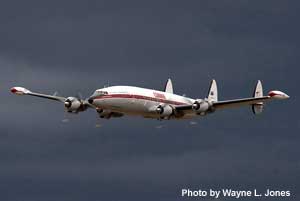 |
 |
Former Lufthansa L1049G on Display at TAP Museum – November 23, 2009
The cockpit, landing gear and a R3350 engine from former Lufthansa Super Constellation D-ALEC are on display at the “Museu TAP Air Portugal” at Lisbon Airport. The aircraft was delivered to Lufthansa in March 1956 and sold to Hank Warton in March 1968 for use on the Biafran Airlift. It carried the false registrations 5T-TAK and N8025 during the airlift and was flown to Lisbon in September 1968 and abandoned. After deteriorating for 13 years, the aircraft was broken up in early 1981 and retired TAP captain Silva Pereira saved the cockpit section and landing gear. Additional components were salvaged from retired Constellations in Santo Domingo.
 |
.jpg) |
.jpg) |
.jpg) |
.jpg) |
.jpg) |
Nantes Super Connie Move - October 19, 2009
Good to his word, Pierre Biron forwarded me photos of the move of Super Connie F-BGNJ at Nantes Airport this weekend. The move team began on Saturday morning at 10am and, after having minor difficulties clearing an airport fence, arrived at the airport’s runway where they would have to wait for the last scheduled aircraft landing before crossing. At 1:30am Sunday morning October 18th the old girl made her way across the runway and by 3:00am arrived safely at her new home at the airport near the Météo France Building close to Fremiou. This location is apparently well know to local spotters.
 |
 |
 |
 |
 |
 |
Good News From Nantes, France - October 16, 2009
There’s finally some good news from Nantes, France regarding Super Constellation F-BGNJ. I received an email from Pierre “Pappy” Biron this week with some details about this recent turn of events. “A decision has been made by the Civil Aviation Direction (DAC), which is a part of the French Transportation Ministry. After months of discussions with ministry, they finally decided to give us authorization to move our Super Constellation out of the military area where she's been parked for two years. They agreed to give us a piece of land on Nantes Airport Area (approximately 2500 m²) and we plan on moving the aircraft the week-end of 17/18 October. The Super Connie’s exterior paint has suffered quite a bit from rain and storms after two years of inactivity and a lot of the work that had been done will have to be done again! The goal of our association is to preserve the aircraft and to restore the interior like it was when it flew with Air France in 1950's, including the small Parisien Special salon.”
All this is going to take money and the association has launched an appeal for donations to fund this restoration effort. If you would like to contribute to this worthy cause, there is a PayPal link on the organization’s website http://superconstellation-nantes.fr which will allow you to make an online donation. Pierre promised some pictures of the move, which I will post when I received them. Good luck to Pierre and the good folks at the Amicale du Super Constellation in their effort to save and restore this aircraft.
Lufthansa Starliner Restoration Project Update - October 10, 2009
In anticipation of having their L1649A airworthy in the next year or so, Lufthansa bought a block of time on Breitling Super Constellation HB-RSC and did some crew training in September. John Barnitz, one of three flight engineers that took part in the flight training, recently sent me an email with the following report.
“After overcoming several obstacles and in close cooperation with the German LBA (Luftfahrt Bundesamt), four pilots and three flight engineers of the Deutsche Lufthansa Berlin Stiftung (DLBS) are now fully licensed on the L-1049 Constellation Series. Flight training and skill tests were performed on the Super Connie Flyers Association (SCFA) Breitling Super Constellation at Epinal France. The final flight to end the season was also a check ride flight for the DLBS captain and flight engineer. The flight departed Epinal and proceeded to the Lahr Blackforest Airport in Germany where the SCFA Super Connie will be towed into the hanger to undergo its winter maintenance checks and service. The DLBS aircrew will continue with development of the required L-1649A flight operations manuals and differences course in preparation for the maiden flight of the Lufthansa L-1649A Starliner.”
It was also reported on the Lufthansa Technik website in August 2009 that Anderson Airmotive would complete the overhaul of six R3350 engines by no later than early October. The website reports that Ray Anderson succeeded in acquiring a large stock of new parts and the six engines will have new crankshafts, piston rods and bearings! Great news on this very exciting project.
Aviodrome Constellation Still Awaiting First Flight - September 26, 2009
Raymond Oostergo sent out an email update to Dutch Constellation donors and supporters on Friday September 25th. In summary, the email said that the Aviodrome still intends to fly the Constellation and is currently plowing through the time consuming paperwork required to do so. In addition to the FAA regulations, Raymond says that the organization must also comply with the Dutch/European regulations. The aircraft continues to receive mechanical attention and Raymond reports that it is airworthy and in excellent condition. Let’s all hope that the bureaucracy’s thirst for paper will be quenched in the near future and this beautiful aircraft finally be allowed to take to the air once again!
 |
 |
 |
MOF Super Connie Reassembled and Moved to Boeing’s Plant II – September 25, 2009

 Wasting no time, MOF began reassembly of CF-TGE on Saturday September 5th. The reassembly was complete by September 13th except for installation of the outer wing panels, tip tanks and propellers. The outer wing panels and tip tanks will not be installed until the aircraft is ready for final display due to a couple of tight spaces along the route to Plant II. Props will be refurbished before being installed on R3350 engines that were donated by Butler Aircraft of Redmond, Oregon. These engines had been installed on Butler’s DC-7 firebomber aircraft and will fill the Super Connie’s empty nacelles very nicely. At 9:00PM on September 15th the move to Plant II began and a short time later the aircraft joined the museum’s B-17 and B-29 aircraft safely inside the Bay 2 of the plant. The aircraft will remain there until permanent display arrangements have been ironed out. Unfortunately it will not be assessable to the general public during the time it is stored in Plant II. A more detailed account of the reassembly and move to Boeing's Plant II can found on Bob’s website.
Wasting no time, MOF began reassembly of CF-TGE on Saturday September 5th. The reassembly was complete by September 13th except for installation of the outer wing panels, tip tanks and propellers. The outer wing panels and tip tanks will not be installed until the aircraft is ready for final display due to a couple of tight spaces along the route to Plant II. Props will be refurbished before being installed on R3350 engines that were donated by Butler Aircraft of Redmond, Oregon. These engines had been installed on Butler’s DC-7 firebomber aircraft and will fill the Super Connie’s empty nacelles very nicely. At 9:00PM on September 15th the move to Plant II began and a short time later the aircraft joined the museum’s B-17 and B-29 aircraft safely inside the Bay 2 of the plant. The aircraft will remain there until permanent display arrangements have been ironed out. Unfortunately it will not be assessable to the general public during the time it is stored in Plant II. A more detailed account of the reassembly and move to Boeing's Plant II can found on Bob’s website.
MOF Super Connie Arrives Safely in Seattle – September 7, 2009
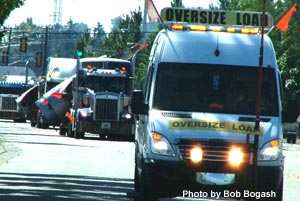
 After a 12 day road trip covering 3,800 miles, Super Connie CF-TGE arrived safely at the Museum of Flight in Seattle, Washington on Friday September 4, 2009. Worldwide Aircraft Recovery was contracted to move the aircraft and the convoy departed the Empire Aero Center facility in Rome, New York on Monday August 24th. After a short stop at the museum’s parking lot, the convoy moved down taxiway Bravo at Boeing Field to Boeing’s Plant II where she will be reassembled. Congratulations to Bob Bogash and the rest of the folks at the Museum of Flight for a job well done! A more detailed account of the epic journey from New York to Washington can be found on Bob’s website as can an account of the aircraft’s arrival at Boeing Field.
After a 12 day road trip covering 3,800 miles, Super Connie CF-TGE arrived safely at the Museum of Flight in Seattle, Washington on Friday September 4, 2009. Worldwide Aircraft Recovery was contracted to move the aircraft and the convoy departed the Empire Aero Center facility in Rome, New York on Monday August 24th. After a short stop at the museum’s parking lot, the convoy moved down taxiway Bravo at Boeing Field to Boeing’s Plant II where she will be reassembled. Congratulations to Bob Bogash and the rest of the folks at the Museum of Flight for a job well done! A more detailed account of the epic journey from New York to Washington can be found on Bob’s website as can an account of the aircraft’s arrival at Boeing Field.
MOF Super Connie Makes Her Final Road Trip – August 26, 2009 – August 26, 2009
 Museum of Flight Super Connie CF-TGE has started her final road trip to a new home at Boeing Field. Disassembly of the aircraft started on August 5th and by August 21st she was loaded on a number of flatbed trucks ready for the long trip ahead. Bob Bogash estimates that, by mid-September, the old airliner will have completed the trip and have been re-assembled in Seattle, with the exception of outboard wings and tip tanks. It will then be stored in a Boeing hangar in Plant II for an indeterminate period of time until the MOF can sort out final display arrangements. This is the location where MOF currently stores their B-17 and B-29 and, while the aircraft won’t be on display to the public, it will at least be kept out of the weather until suitable display arrangements can be made. Check out Bob's website for the latest on the progress of the move and lots of additional photos.
Museum of Flight Super Connie CF-TGE has started her final road trip to a new home at Boeing Field. Disassembly of the aircraft started on August 5th and by August 21st she was loaded on a number of flatbed trucks ready for the long trip ahead. Bob Bogash estimates that, by mid-September, the old airliner will have completed the trip and have been re-assembled in Seattle, with the exception of outboard wings and tip tanks. It will then be stored in a Boeing hangar in Plant II for an indeterminate period of time until the MOF can sort out final display arrangements. This is the location where MOF currently stores their B-17 and B-29 and, while the aircraft won’t be on display to the public, it will at least be kept out of the weather until suitable display arrangements can be made. Check out Bob's website for the latest on the progress of the move and lots of additional photos.
Camarillo and Helena EC-121T Projects Move Forward – August 26, 2009
 The crew of a half dozen mechanics from Yanks Museum has been working hard all summer getting EC-121T 54-548 (N548GF) ready for FAA inspection and hopefully a ferry flight to Chino, California. I spoke with Yanks Museum project lead Frank Wright in mid-August and said that their effort is winding down. Work completed this summer includes removal of two years accumulated bird nests and droppings; installation of new rudders; repair of elevator and rudder trim tabs; repair of flaps; removal of exfoliation; and an overall cleanup of the aircraft. Frank expects that aircraft to be ready for FAA inspection some time in early September and, if things go well, a gear swing will be completed and work will begin on getting the engines ready for the flight. Let’s keep our fingers crossed and perhaps, with some luck, the long-delayed ferry flight might occur this fall. In addition to Frank, the Yanks crew includes Gary Graves, David Waterman, Bobby Carter, Tony Furikawa and Dan Twmoi.
The crew of a half dozen mechanics from Yanks Museum has been working hard all summer getting EC-121T 54-548 (N548GF) ready for FAA inspection and hopefully a ferry flight to Chino, California. I spoke with Yanks Museum project lead Frank Wright in mid-August and said that their effort is winding down. Work completed this summer includes removal of two years accumulated bird nests and droppings; installation of new rudders; repair of elevator and rudder trim tabs; repair of flaps; removal of exfoliation; and an overall cleanup of the aircraft. Frank expects that aircraft to be ready for FAA inspection some time in early September and, if things go well, a gear swing will be completed and work will begin on getting the engines ready for the flight. Let’s keep our fingers crossed and perhaps, with some luck, the long-delayed ferry flight might occur this fall. In addition to Frank, the Yanks crew includes Gary Graves, David Waterman, Bobby Carter, Tony Furikawa and Dan Twmoi.
Progress is also being made on long time Helena resident EC-121T 52-3417 (N4257L). As reported previously on this website, the Evergreen Air and Space Museum acquired this aircraft in May 2009 and plans to restore and fly the veteran aircraft to its McMinnville, Oregon museum facility. Karl Kruger, a former instructor at the UM-Helena College of Technology, has joined the museum as the Director of Restoration and is the museum’s project point man in Helena. Constellation experts JR Kern and Tim Coons traveled to Helena in late July and performed a thorough inspection of the aircraft. JR and Tim reported that the inspection revealed a few things that need attention, but overall the aircraft proved to be in remarkably good condition for having been exposed to the great Montana outdoors for 28 years. Apparently the biggest issue is going to be the removal of 28 years worth of bird droppings and nests. The condition of the engines is still in question, but the museum is hopeful that the current engines can be coaxed into making the short ferry flight to Oregon. The current plan is to get a crew to Helena next month to start the process of removing the accumulated bird droppings and nests. After this is completed, the aircraft will be towed off the school’s property and moved to another location on the airport. Evergreen curator Stewart Bailey has been in touch with Frank Wright of the Yanks Museum and Frank has provided him with some good advice on how to best proceed with the project. Bottom line is that it looks like the aircraft can be made airworthy for the ferry flight, which probably won’t occur until at least the summer of 2010.
MOF Super Connie Disassembly Starts Today at EAC – August 5, 2009
 I received this report today from Bob Bogash, the Museum of Flight’s (MOF) project manager, on the latest status of the museum's Super Connie restoration project. “The disassembly of CF-TGE started today. It will transported by ground and arrive in Seattle around the end of the month…plus or minus a week. It will be partially reassembled (no outboard wing panels or tip tanks) and then stored in a hangar at Boeing's Plant 2 for an indeterminate period of time while the MOF sorts out the final display arrangements. There is a plan to place it "under cover", but final details have yet to be worked out.” Thanks Bob for the report and thanks Janet for the gorgeous photo.
I received this report today from Bob Bogash, the Museum of Flight’s (MOF) project manager, on the latest status of the museum's Super Connie restoration project. “The disassembly of CF-TGE started today. It will transported by ground and arrive in Seattle around the end of the month…plus or minus a week. It will be partially reassembled (no outboard wing panels or tip tanks) and then stored in a hangar at Boeing's Plant 2 for an indeterminate period of time while the MOF sorts out the final display arrangements. There is a plan to place it "under cover", but final details have yet to be worked out.” Thanks Bob for the report and thanks Janet for the gorgeous photo.
Antti Hyvärinen Visits Greenwood Lake Connie - August 2, 2009
Antti Hyvärinen recently completed a whirlwind one week trip of the northeast United States from Connecticut to Northern Virginia. One of the stops on his agenda was Greenwood Lake, New Jersey, which is home to L049 Constellation N9412H. While the weather didn’t exactly cooperate, Antti got some nice shots of the old girl in her new paint scheme on June 27th. For the time being it appears that the veteran airliner is safe from the scrappers and is being well taken care of. Thanks Antii for sharing the photos.
 |
 |
 |
 |
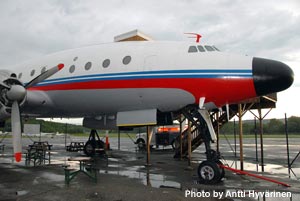 |
 |
Connie Reunion in Rome, New York – August 1, 2009
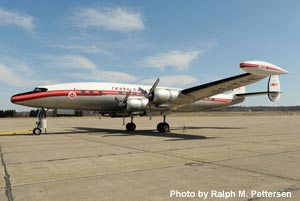
 A reunion of sorts was held at the Empire Aero Center in Rome, New York on Thursday July 23rd, when a group of former TCA and WWA employees met to have one last look at Super Constellation CF-TGE before she gets dismantled and shipped off to her new home at the Museum of Flight in Seattle, WA. Bob Bogash and Larry Milberry have both updated their websites with poignant accounts of the meeting. Thanks guys for sharing the story.
A reunion of sorts was held at the Empire Aero Center in Rome, New York on Thursday July 23rd, when a group of former TCA and WWA employees met to have one last look at Super Constellation CF-TGE before she gets dismantled and shipped off to her new home at the Museum of Flight in Seattle, WA. Bob Bogash and Larry Milberry have both updated their websites with poignant accounts of the meeting. Thanks guys for sharing the story.
July 2009 Visit to Salina, Kansas – July 17, 2009
When I spoke to Gordon Cole in June, he told me he would be in Salina working on his Constellation (N1206) for about a week starting July 8th. I checked out airfares and decided to make the trip when I found out that Southwest Airlines was having an airfare sale and the flight from BWI to MCI was only $69 each way. I arrived at Kansas City the morning of July 8th and 3 hours later I was in Salina eating a BBQ sandwich at the Hickory House with Gordon, his 17 year old son Robert and the Connie’s Salina “caretaker” Larry Bruzda. Our timing was perfect as Gordon and Robert had arrived in Salina only 15 minutes before me. After finishing our lunch, the first order of the day was to get out to the airport as the Collings Foundation’s B-17, B-24 and P-51C were scheduled to arrive at 2:00 pm for a three-day stay in Salina. The P-51C arrived first with the B-24 arriving a few hours later and the B-17 arriving the next day because of a tail wheel problem. Not bad for a trio of airplanes that easily qualify for Social Security!
 |
 |
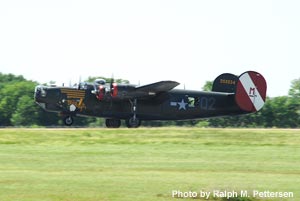 |
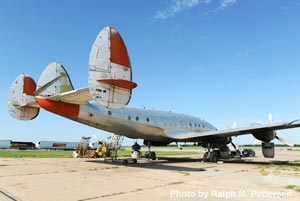 |
 |
 |
 |
 |
 |
 |
 |
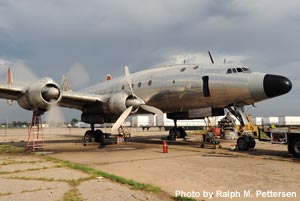 |
 |
 |
 |
 |
 |
 |
I’d like to thank Gordon, Larry and Robert for making me part of their small group. I had a great time and hope that I was able to contribute to the cause. If you have some mechanical ability and live in the area, Gordon would love to hear from you. Please email him and tell him that you read about his Connie on this website.
Salina Connie Update – June 15, 2009
Gordon Cole is making steady progress towards his goal of getting Constellation N1206 back in the air this year. He has enlisted MATS Connie veteran mechanics JR Kern and Tim Coons and, along with his 16-year old son Robert, they mounted the replacement #1 engine on a QEC this weekend. Gordon plans to install accessories and hoses during the next week or so and hopefully have it in Salina, ready for installation, by the end of June. Robert helped him remove the bad engine in Salina back in the spring and will be helping Gordon this summer getting the old girl back in the air. The Collings Foundation is visiting Salina on July 8th thru July 10th and wouldn’t it be great to see Gordon’s Connie parked alongside the B-17 and B-24?
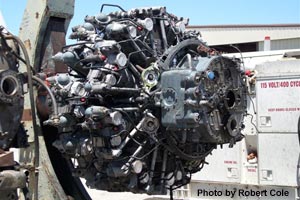 |
 |
 |
Aviodrome Connie Update - June 8, 2009
There hasn't been much in the way of an official statement from the Aviodrome or the Holland Aviation House board members since internet reports surfaced a few weeks ago that the Aviodrome's Constellation wouldn't be flying this summer. On June 4th the Dutch website www.luchtvaartnieuws.nl published a news report, in Dutch, quoting Aviodrome spokesman Peter van de Noort. Here's an English translation of what was posted on the website.
"Another aircraft from the Aviodrome collection, the Lockheed L-749 Constellation, will possibly not fly this year, contrary to earlier plans. According to spokesman Peter van de Noort of the aviation themepark, the financial risks are too great at this moment for the four-engined airliner to fly. "We are looking into the possibilities of flying the aircraft later this year or next year," Peter van de Noort adds. Van de Noort does not exclude the possibility of flying the aircraft if another sponsor can be found. The aircraft will remain grounded as long as this is not the case. Van de Noort emphasizes that volunteers will continue to work on the aircraft. To keep the plane airworthy the engines will be run regularly, and taxi runs will be held at Lelystad Airport."
Lufthansa Starliner Restoration Project Update - June 4, 2009
Auburn-Lewiston Airport in Maine has become the epicenter of Starliner activity since Lufthansa purchased Maurice Roundy’s three Starliners in December 2007. Lufthansa operated four L1649A’s in passenger and cargo service from 1957 to 1966 and are currently restoring former TWA Starliner N7316C to fly for Lufthansa on international missions. This is no normal restoration, but a three year effort that will result in a pristine “like new” airliner when completed. I visited Auburn on Friday May 29th and toured the Lufthansa restoration hangar with Michael Austermeier, Lufthansa’s on-site restoration project manager.
 |
 |
 |
 |
 |
 |
 |
 |
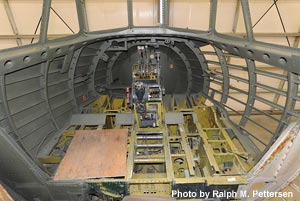 |
 |
 |
 |
Airline History Museum Executive Director Resigns – May 28, 2009
Paul Sloan, the controversial AHM Executive Director, resigned his position before a special meeting of the Board of Directors on May 16, 2009. For the past year or so there has been growing discontent amongst AHM members about Paul’s $120,000 a year salary and the manner in which the museum was being run. Larry Brown, one of the founders of the organization, was named acting Executive Director until a permanent replacement can be found.
For some time I’ve heard rumblings about problems and discontent at AHM. In January 2009 I received a detailed, but unsigned, letter alleging continued problems at the museum. I forwarded the letter to Paul Sloan and he responded with an email, addressing many of the allegations and assuring me that things were turning around. Based on his response I decided I would hold off on posting a news article on this website describing the alleged problems. If the organization was indeed successful in flying the Super Connie this year, perhaps AHM was indeed being turned around by its new executive director.
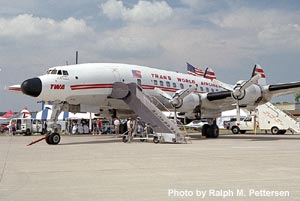 |
 |
 |
Both Larry and Gwyn were positive about the future of the museum. Larry Turpin, a senior A&P, has been hired as the new Director of Maintenance and is working exclusively on the Super Constellation. The museum hopes to get the aircraft back in the air sometime this summer. Larry also noted that they will also be receiving an airworthy former TWA L1011 which will be flown to Kansas City and parked at the front entrance to the museum. While this doesn’t quite fit the “propliner” theme of the museum, hopefully this will act as a giant signboard and attract additional visitors to the museum. The L1011 has a full passenger interior and is currently parked at Roswell, New Mexico awaiting the ferry flight to Kansas City’s Downtown Airport. I’d like to thank Larry and Gwyn for their responses and wish Larry Brown luck in getting things back on an even keel.
Here are links to the two articles posted on The Kansas City Star website on May 16th. The first gives a good general overview of the problems facing the museum and the second announces Paul Sloan’s resignation.
Holland Aviation House Pulls the Plug on the Dutch Connie – May 22, 2009
According to a number of sources, last Saturday volunteers at the Dutch Aviodrome were informed by Aviodrome/DDA management that the Aviodrome’s Constellation N749NL wouldn’t be flying this year, or for that matter, any time in the future. No explanation was given…just the blunt statement “it will not fly”. After more than eight years of overcoming one obstacle after another to get the airplane ready for flight, this was a bombshell that justifiably caused quite a bit of consternation amongst the volunteers with a number of them vowing to quit the organization. The part that was most upsetting to the volunteers was that no explanation was given as to why this decision was being made.
I have first hand knowledge of the condition that N749NL was in when the restoration began in the spring of 2001 (see photo below). I also have first hand knowledge of how hard volunteers worked in very harsh Arizona conditions to get her airworthy for the ferry flight back to Holland in September 2002. I had the pleasure of flying on this beautiful airplane during test flights in Arizona and I can personally vouch that she is a beautiful sight to behold while in flight! Kudo’s to the volunteers for at least performing the high speed taxi runs on Tuesday May 19th to show off their prize to the rest of the aviation world! The aircraft performed flawlessly during these runs with only the most minor of items needing correction. She was reportedly judged ready to fly.
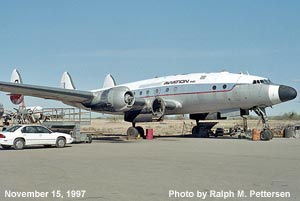 |
 |
 |
The good news is that the board seems to have left the door open to operating the aircraft in the future if those operations are performed within a structured flight operations program. Perhaps this would be similar to the manner in which DDA operates their DC-3, which is as an airline under an official AOC. This would possibly mean that the aircraft would be given a Dutch registration and perhaps operated under DDA's AOC. Raymond Oostergo, of the Aviodrome, also stated today that the aircraft, in spite of the internet rumors, will fly after “necessary preparations” have been completed. I don’t know what those “necessary preparations” entail but I have known Raymond for a number of years and if he says the aircraft will eventually fly, I believe it.
So, that my friends is the WHY of the decision. In my humble opinion, the manner in which the volunteers were notified was nothing short of disgraceful. The volunteers labored for years to get this aircraft ready for flight. Provisional airshow commitments were made; large sums of money were raised through donations; FAA approval regarding aircrew certification was finally obtained; engines were swapped with the Connie in Korea; and Tim Coons and Al Malecha were brought to Holland to crew the aircraft. All this was done only to have the rug pulled out from underneath the project in the last minute. Did the board delay their decision thinking that the volunteers wouldn’t succeed in making the aircraft airworthy? Or, did they delay the decision so that the volunteers would finish the restoration before they got the bad news? I would surely hope that the board would come to their senses and, in short order, release a letter of apology and explanation of their decision to the Aviodrome volunteers. Volunteers are the core of this organization and to alienate them would have far reaching implications. Board members…you don’t have much time to correct this wrong! Better late than never!
If you would like to voice your opinion regarding this matter, please email Peter van de Noort, the Aviodrome's spokesperson. Perhaps your opinion might matter to the board.
An Insider’s Prospective Regarding the Disposal of the Helena EC-121T – May 22, 2009
I received an email today from Karl Kruger, an instructor in the Aviation Department at the University of Montana - Helena College of Technology. He had read my May 20th news article and wanted to give his perspective on the recent news about EC-121T 52-3417. His email provides some very interesting insight regarding the schools decision to dispose of the Super Connie.
"I have been perusing the stories and blogs that have been circulating lately about the transfer of the Connie from Helena MT to the Evergreen Aviation and Space Museum. I would hope to give you my short take on the project and offer some insight as to why the decision was made to find a new home for her.
I started teaching at the college in 2007 and have just finished up my second year. During my first year we focused a lot of much needed attention to her, over the years the Montana weather has taken its toll on the paint and the pigeons use her as a large condominium. During my first year of teaching I had several interested students approach me with offers to begin a process to attempt to slow the degradation and to preserve what was left.
We did have a couple of fund raisers in the form of a haunted airplane, which, originally was to generate money for aviation student trips but much of the first years funds were used to help preserve the airplane. So, the haunted airplane had a two-fold purpose, the second was a way to promote awareness of the aircraft and gain some much needed attention from the community.
Several of the students have taken ownership of her and put in many hours of their free time cleaning the cockpit and cabin, removing and cleaning carburetors which were stuffed full of pigeon droppings and nests, fabricating duct plugs and pressure washing all four engines.
The next step required all of us involved to be realistic, although the aircraft is great to look at, unless a community has the facilities to house such an aircraft and protect it from the elements, there is only so much a handful of students with limited funds can do. Not only is the cost of such a facility an issue, probably upwards of one million dollars, (there is no existing hangar in Helena physically large enough to house her) land around the airport is at a premium, we could go on about the logistics. Add to that cost another half million or so just for an appropriate restoration that would make her presentable. The aircraft has been in Helena since 1981 and as far as I know, there has been no one that has approached the college with an offer to fund such an endevour to allow the airplane to remain in Helena.
So, the Helena Connie is going to a good home that has the resources to preserve and protect her. If you've never taken a trip to the Evergreen Aviation and Space Museum, I would highly suggest you head out to McMinnville, Oregon and look at the facility. The organization loves and appreciates airplanes and it shows, it's a dynamic, ever changing facility that strives to protect the heritage of aviation, in my humble but accurate opinion it rivals many of the larger aviation museums.
The Helena Connie has outlived her usefulness as a training aid, so now she gets to move on to a new life as a teaching aid, she isn't going to be scrapped, she is going to be preserved, how can that be a bad thing? She isn't being moved because the school doesn't want her, it's being done to provide space for educating more students and again, to preserve history. I hope in the future people can visit her in Oregon and remember where she came from. "
Best regards,
Karl
Karl Kruger
UM Helena Aviation Maintenance
2300 Airport Road
Helena, MT. 59601
I’d like to thank Karl very much for taking the time to send the email. It provides goes a long way in explaining the school’s decision.
Evergreen Air & Space Museum Receives Helena EC-121T 52-3417 – May 20, 2009
Back in November 2008 I received an email from friend, and fellow aviation enthusiast Bob Bogash, forwarding a very interesting email he had received from Blair McAnally. As reported on this website on November 8, 2008 and December 26, 2008 , the University of Montana – Helena College of Technology had declared long-time training airframe EC-121T 52-3417 surplus and were looking for a new home for the veteran aircraft. Blair, who is a Production Superintendent at the 120th FW of the Montana Air National Guard, was leading the charge on saving the aircraft and my November 8, 2008 news article generated quite a bit of interest in the museum and warbird communities. I’m happy to report today that the old Connie has found a home at the Evergreen Air & Space Museum and that the paperwork transferring ownership to the museum was signed yesterday in Salem, Oregon by GSA and museum representatives.
 |
 |
 |
I first became aware of Evergreen’s interest in the aircraft in early February 2009 when I received an email from the museum’s curator, Stewart Bailey, saying he had read about the aircraft on my website and asking for Blair McAnally’s contact information. We have been in contact since then and I was very pleased to hear from Stewart on Thursday May 14th that the museum had been selected by GSA to receive the aircraft. This is indeed good news for all involved as the McMinnville, Oregon based museum has ambitious plans for restoring the aircraft.
The museum plans to make the aircraft airworthy and flying it from Helena to their overhaul and maintenance base at Marana, Arizona, where a complete inside-out restoration will be performed. According to Stewart, the restoration will take at least six months after which the EC-121T will make her final flight to museum headquarters in McMinnville where she will be put on permanent static display. At this time, the museum has no plans for keeping the aircraft airworthy. The interior of the aircraft, essentially complete after all these years, will be restored to absolutely military stock, and possibly be opened up for public display. One member of the Evergreen team, JR Kern, was part of the crew that flew 52-3417 from Tucson to Helena back in 1981. That flight was commanded by Frank Lang, of MATS Connie fame, and JR was his young co-pilot. JR was lead mechanic and flight engineer for Vern Raburn’s Constellation Group, which flew the MATS Connie (N494TW) on the US airshow circuit from 1992 through 2004. JR will be part of the team that gets the EC-121T ready for her ferry flight back to Marana, which is a few miles north of Tucson. JR and his involvement with this aircraft appear to have come full circle after almost 30 years!
With any luck, we may witness two EC-121’s take to the air in the next 12 months! Keep posted for updates on this very exciting development. For additional information about the project, a very interesting article was published May 18th on the Victoria Advocate website.
Crash Landing at Williams Field, McMurdo, Antarctica – May 15, 2009
In October 2005 I published an article on this website documenting the crash landing of WV-2 BuNo 126513 “Paisano” at Williams Field at McMurdo. The article was written by US Navy veteran Ricky DeRoo who was an eyewitness to the event. Ricky had the forsight to photograph the wreck and also provided those photos for publication. I recently received an email from Cleland McBurney who was the ops officer at McMurdo on that fateful day and also witnessed the crash landing. Here is his account of the accident.
“Thank you for an excellent website! I was captured by the article submitted by Ricky DeRoo on the Williams Field crash of the Project Magnet WV-2 on 31 October 1960. I was the Operations Officer in charge of Williams and also witnessed the crash scenario. It was exactly as Ricky reported. Ricky was under my department working for Chief Guy Henry who headed up the Crash & Fire Fighting capability we had. He also ran the 3 million gallon fuel farm at McMurdo.
Ricky's description is good. I have a slightly different slant on it. We did not have ILS at that time, but we had Ground Controlled Approach radar (GCA), which is as good as ILS, or in my humble opinion was better. It was of course as a manned position that brought those Antarctic aircraft down to the only wheel landing in Antarctica. They left Christchurch, NZ 2200 nautical miles away. Our GCA was the only way down.
The Project Magnet aircraft landed on an overcast but clear day on the crosswind runway as I recall was 8,000' runway 18. The previous Deepfreeze party had marked the runway threshold with 55 gallon drums frozen into the snow. Bad place for an obstruction. The Connie had made another landing at McMurdo earlier, and the Pilot in Command had switched places with his co-pilot to allow him to log making a landing on the ice. On downwind leg of the landing pattern, when gear down was selected, the nose gear light remained in the red. Concerned about this, the Pilot in Command sitting in the right seat had the navigator check the position of the nose gear with his drift sight. During this time I believe they recycled the gear, getting the same red light, while their co-pilot continued the landing. The PC did not fasten his shoulder straps, not ready for a landing, but was working with the navigator on the light problem.
When the plane rolled out on final approach, the pilot flying had problems with depth perception due to the snow field and overcast, and landed about 400' short of the runway. He immediately added full take-off power, but his left landing gear struck one of the 55 gallon drums and collapsed the gear. The left wing came down and dragged on the ice causing a left swerve. It slid 2200 feet down the runway past the intersection of runway 270-90, and came to rest upon the ice berm clear of the runway as you see in the photos take by Ricky. I certainly appreciate the good pictures of the event since I didn't have anything of this crash except my 8mm camera.
I can verify that gasoline was pouring over the hot manifolds, but in the Antarctic, the cold weather prevented an ignition and fire. One passenger was Commander Bill Salisbury from the Australian Navy, stationed at Hobart, Tasmania who was on board as a guest. He became my roommate for the next 5 days until VX-6 squadron could fly him out to New Zealand! We did have a long visit! No injuries were sustained however, except for the Pilot in Command sitting in the co-pilots seat. Without his shoulder harness locked, his head struck the glare shield in the cockpit, and caused a cut to his forehead. Lucky man!
Project Magnet had on board two inertial navigation systems for accurate navigation over water and uncharted areas like they were flying over in the Antarctic. The mission was to plot magnetic variation for mapping for the Navy's Oceanic Survey that printed our navigation charts. Variation of course constantly changes, and their mission was to record it. Nothing more or less. El Paisano was outfitted at the Overhaul & Repair depot at NAS Corpus Christi, TX and the term "El Paisano" is the Mexican name for the roadrunner that is a popular bird in south Texas. I understand the replacement WV-2 was named "El Paisano Dos".
Our runways were 8,000' long and 200' wide. Landing in a 'whiteout" condition, the 200' width was appreciated. On occasion I flew with VX-6 doing aerial mapping, and with the R4D on one occasion resupplying a survey party on the snow cap. I flew the DeHaviland Otter on skis and flew practice GCA runs on our unit."
Lcdr. Cleland McBurney, USN (Retired)
Thanks very much to Cleland for this fascinating account of an event from long ago.
Lufthansa Finds Pax Doors for L1649A N7316C – May 6, 2009
 As reported February 3, 2009 on this website, Lufthansa has been looking for a set of passengers doors to replace the cargo doors on N7316C. I received an email from Reiner Matzner today and I’m glad to report that Lufthansa has apparently succeeded in locating the doors. As reported on the Deutsche Lufthansa Berlin Stiftung website, the South African Airways Museum has offered up passenger doors from their L1649A ZS-DVJ. This particular aircraft was delivered to Lufthansa in January 1958 as D-ALOL and had a relatively brief career with the German carrier before being leased to World Airways as N45520. The aircraft went to Trek Airways in May 1965 and was registered ZS-DVJ. It flew with Luxair and South African Airways before being retired and is currently on display in Johannesburg, South Africa in Trek Airways colors. Replica doors are being built in Hamburg, Germany to replace the doors being shipped to Maine for N7316C. Thanks very much to Reiner for passing on the good news.
As reported February 3, 2009 on this website, Lufthansa has been looking for a set of passengers doors to replace the cargo doors on N7316C. I received an email from Reiner Matzner today and I’m glad to report that Lufthansa has apparently succeeded in locating the doors. As reported on the Deutsche Lufthansa Berlin Stiftung website, the South African Airways Museum has offered up passenger doors from their L1649A ZS-DVJ. This particular aircraft was delivered to Lufthansa in January 1958 as D-ALOL and had a relatively brief career with the German carrier before being leased to World Airways as N45520. The aircraft went to Trek Airways in May 1965 and was registered ZS-DVJ. It flew with Luxair and South African Airways before being retired and is currently on display in Johannesburg, South Africa in Trek Airways colors. Replica doors are being built in Hamburg, Germany to replace the doors being shipped to Maine for N7316C. Thanks very much to Reiner for passing on the good news.
Aviodrome Connie Rolled Out of Hangar Today - May 2, 2009
Dutch enthusiasts have something to cheer about. Aviodrome Constellation N749NL was rolled out of the museum’s hangar this morning and it appears that a flight may be in the near future. Michael S. Prophet reports “Moving the aircraft out of the hangar is not as easy as it sounds because the width of the Connie wings is greater then the hanger door opening. A special big lift company was hired to move the Connie and the aircraft was lifted and special movable bogies placed under the main wheels so that the aircraft could be moved in all directions.” Michael goes on to report that many of the smaller aircraft parked outside had to be moved as well, including the DC-4 that had been parked in the Constellation’s outdoor parking spot. Personnel at the Aviodrome are well versed in the drill as they have performed it a number of times over the past few years. Michael was kind enough to send along some very nice photos of the move today. The weather in Lelystad (sunny) was much better than what it was in Maryland today (cloudy with rain)!
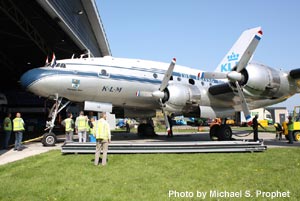 |
 |
 |
Speedpack Wanted – April 29, 2009
I spoke to Gordon Cole today and he told me that he would be working on his spare engine this weekend getting it ready for installation on N1206. The task in hand is to remove the accessories and exhaust system from the failed #1 engine and reinstall them on the replacement engine. Once this is done the engine will be ready to install on the aircraft and she will be one step closer to getting back in the air. Gordon has identified a crew for the flight and they consist of highly experienced propliner veterans. After the FAA bought N1206 in 1958, they send it back to Lockheed to have it essentially converted back to civilian standards. Lockheed installed the attachment fittings for a Speedpack and Gordon would like to get his hands on one to install on the airplane. Lockheed built 75 Speedpacks in the late 1940’s for a number of airlines including Eastern, KLM, TWA. If you know of anyone who has one that they are willing to part with, please send Gordon an email with the particulars.
Yanks Museum Crew Working on Camarillo EC-121T – April 25, 2009
 Terry Wall reports that a three man crew from Yanks Museum is busy working on EC-121T N548GF getting her ready for the short ferry flight to Chino Airport. Terry has been keeping on eye on the old girl for me for some time and noticed last week, while driving by the airport on the freeway, that a door was open on the aircraft. On his first trip to the airport, a week ago Friday, he found a Yanks truck and stairs and this week he found a three man crew working on the airplane. He spoke to Frank Wright, of the Yanks Museum, who told him that they were preparing the airplane for the ferry flight and were about three weeks from having her ready to go. Great news and hopefully the FAA will give its full blessing to the ferry flight soon! Thanks to Terry for the timely update.
Terry Wall reports that a three man crew from Yanks Museum is busy working on EC-121T N548GF getting her ready for the short ferry flight to Chino Airport. Terry has been keeping on eye on the old girl for me for some time and noticed last week, while driving by the airport on the freeway, that a door was open on the aircraft. On his first trip to the airport, a week ago Friday, he found a Yanks truck and stairs and this week he found a three man crew working on the airplane. He spoke to Frank Wright, of the Yanks Museum, who told him that they were preparing the airplane for the ferry flight and were about three weeks from having her ready to go. Great news and hopefully the FAA will give its full blessing to the ferry flight soon! Thanks to Terry for the timely update.
Empire Aero Center Completes the Restoration of L1049G CF-TGE - April 20, 2009
I visited Empire Aero Center (EAC) in Rome, New York on Friday April 17th to photograph L1049G CF-TGE (formally CF-RNR). This aircraft arrived at EAC in pieces from Toronto, Canada on June 7, 2007 and the transformation has been nothing short of remarkable. The old Connie arrived in near derelict condition after years of neglect and Kevin Lacey and his team at EAC immediately went to work on restoring her to her former glory for display at the Museum of Flight in Seattle, Washington. Bob Bogash, who heads the project for the museum, Kevin Lacey, Randy Buol and the rest of the team at EAC deserve lots of credit for their magnificent effort in saving this classic aircraft. CF-TGE will be disassembled and moved to Seattle in the near future. For much more information on the project, check out Bob's fantastic website, where he has documented the entire restoration effort.
 |
 |
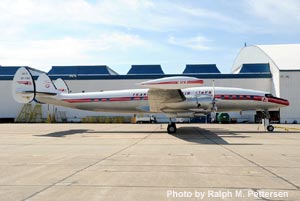 |
Salina Connie Resurrection – April 16, 2009
As reported on this website on March 7, 2009, work is progressing on the restoration of L749A N1206. If Gordon Cole has his way, the United States will again have an airworthy Constellation flying in the near future. Gordon, who has owned N1206 since 1983, has begun restoration of the aircraft at Salina, Kansas where it has been an airport fixture since 1967. The airport is planning on developing the land where the aircraft is parked and has notified Gordon that the aircraft must be moved. Work on the aircraft began in December 2008 with the pace picking up in early March when the winter weather broke. I recently spoke to Gordon about his current effort to get the aircraft airworthy and back flying again. During the past few months he has been making an 18-hour “commute” between his home and Salina to work on N1206. He has a small, but dedicated, group of volunteers assisting him in Salina including a number of students from Kansas State’s College of Technology and Aviation in Salina. One of these student volunteers, Scott Harmon, recently enlisted in the Kansas National Guard and will be heading off to basic training and helicopter mechanic school. He was an enthusiastic volunteer and his great attitude and energy will be missed by Gordon and the rest of the crew.
 |
 |
 |
 |
 |
 |
Gordon deserves a lot of credit for keeping this beautiful aircraft from falling victim to the scrap metal merchants. If you are interested in becoming a sponsor or contributing to this project, please email Gordon.
Rantoul Willy Victor Heading to Hawaii? – April 7, 2009
 I received an email today from Brad Hayes, Executive Director of the Naval Air Museum Barbers Point. Brad says in the email that “We are willing to “adopt” the Rantoul Willy Victor (BuN 141311) if the different Connie groups can generate the funds to move her back home to NAS Barbers Point, Hawaii where she was once stationed. It will take all the help these guys can generate and money they can get. Only then will the Navy sign off on the project. Has to be a grassroots effort though. Looking at a $500 pledge from EVERY Willy Victor Crewman out there and a $200 pledge from EVERY CONNIE SUPPORTER out there as well.” The move is, of course, dependent on the Chanute Air Museum and National Museum of Naval Aviation agreeing to the move and the success of a fundraising campaign. The aircraft is currently on display at the Chanute Air Museum in Rantoul, Illinois. Stay tuned for additional details.
I received an email today from Brad Hayes, Executive Director of the Naval Air Museum Barbers Point. Brad says in the email that “We are willing to “adopt” the Rantoul Willy Victor (BuN 141311) if the different Connie groups can generate the funds to move her back home to NAS Barbers Point, Hawaii where she was once stationed. It will take all the help these guys can generate and money they can get. Only then will the Navy sign off on the project. Has to be a grassroots effort though. Looking at a $500 pledge from EVERY Willy Victor Crewman out there and a $200 pledge from EVERY CONNIE SUPPORTER out there as well.” The move is, of course, dependent on the Chanute Air Museum and National Museum of Naval Aviation agreeing to the move and the success of a fundraising campaign. The aircraft is currently on display at the Chanute Air Museum in Rantoul, Illinois. Stay tuned for additional details.
All Constellation Parts at Camarillo Airport Must Go By April 7th – March 14, 2009
As reported on this website (see January 7th report below), Dave Green has three sea containers full of slightly used Super Constellation parts for sale. There will be open houses on March 14th, March 21st and April 7th for prospective buyers to come out and have a look at the goods. Dave can be contacted via email or by cellphone at 818-231-5776. Here's a link to a list of available parts, as of March 14th.
Parts Reclamation Continues on Starliner N974R at Fantasy of Flight Museum – March 13, 2009

 Mark Fidler visited the Fantasy of Flight museum in Polk, Florida on March 11th and emailed some photos of Starliner N974R. He reports that a crew was removing parts from N974R and his photos show activity around the aircraft. Parts are being salvaged from this aircraft in support of Lufthansa's restoration of sister ship N7316C at the Auburn-Lewiston Airport in Maine (see March 1st report below). The aircraft paint looks terribly faded but it has been reported that Lufthansa will paint N974R in full Lufthansa colors for display at the museum. Thanks Mark for the photos and report. (Additional photos taken by Joe Amend on March 13th posted on the Photobucket website)
Mark Fidler visited the Fantasy of Flight museum in Polk, Florida on March 11th and emailed some photos of Starliner N974R. He reports that a crew was removing parts from N974R and his photos show activity around the aircraft. Parts are being salvaged from this aircraft in support of Lufthansa's restoration of sister ship N7316C at the Auburn-Lewiston Airport in Maine (see March 1st report below). The aircraft paint looks terribly faded but it has been reported that Lufthansa will paint N974R in full Lufthansa colors for display at the museum. Thanks Mark for the photos and report. (Additional photos taken by Joe Amend on March 13th posted on the Photobucket website)
AMC Museum at Dover AFB Finds a Long Nose Radome For Its "Faux" C-121C - March 9, 2009
After an extensive search for a long nose radome for their “faux” C-121C aircraft, the Air Mobility Command Museum finally has found one and it’s on its way to Dover AFB in Delaware. The museum had restored L1049E N1005C to represent a C-121C transport aircraft but the aircraft had a short nose radome rather than the longer nose radome that characterized the C-121C fleet. Gordon Cole, who owns L749 N1206, had an spare radome and recently sold it to the museum. The museum is still looking for an extension plug, which serves as a fairing between the nose of the aircraft and the radome. If the museum is unsuccessful in locating this necesssary part, they plan manufacturing a replica. Included are photos of the radome at Salina, Kansas where it is crated and ready to be shipped; L1049E N1005C at Dover AFB with a short radome; and C-121C 54-155 at Lackland AFB with the long radome.
 |
 |
 |
N1206 Being Prepped for Reported Ferry Flight – March 7, 2009

 While visiting the AMC Museum today at Dover AFB I was informed that Gordon Cole’s unique Constellation was being worked on at Salina, KS and that at least one of the engines had been run during the past week. On arriving home I received an email from Vernon Christie reporting that indeed the aircraft was being prepped for a ferry flight. Vernon said that there was a crew working on the aircraft today and forwarded some photos showing activity around the aircraft and that the #1 engine had been removed. Apparently the airport needs the space where the aircraft has been parked for many years and the crew is facing a March 31st deadline. Rumor around the airport says that the old girl is headed to the Mid-America Air Museum in Liberal, Kansas. Some may remember that Gordon attempted to fly the aircraft to Texas back in November 1992 and had to turn back to Salina when engine problems developed. The aircraft has been grounded ever since and, if the rumor proves true, it’s great that this fine aircraft has found a good home. Gordon deserves a lot of credit for saving it from the scrapman and I wish him luck on this latest endeavor. Thanks very much to Vernon Christie for his report and photos. He has posted additional photos on the Photobucket website.
While visiting the AMC Museum today at Dover AFB I was informed that Gordon Cole’s unique Constellation was being worked on at Salina, KS and that at least one of the engines had been run during the past week. On arriving home I received an email from Vernon Christie reporting that indeed the aircraft was being prepped for a ferry flight. Vernon said that there was a crew working on the aircraft today and forwarded some photos showing activity around the aircraft and that the #1 engine had been removed. Apparently the airport needs the space where the aircraft has been parked for many years and the crew is facing a March 31st deadline. Rumor around the airport says that the old girl is headed to the Mid-America Air Museum in Liberal, Kansas. Some may remember that Gordon attempted to fly the aircraft to Texas back in November 1992 and had to turn back to Salina when engine problems developed. The aircraft has been grounded ever since and, if the rumor proves true, it’s great that this fine aircraft has found a good home. Gordon deserves a lot of credit for saving it from the scrapman and I wish him luck on this latest endeavor. Thanks very much to Vernon Christie for his report and photos. He has posted additional photos on the Photobucket website.
Lufthansa L1649A Starliner Restoration Continues at Auburn-Lewiston Airport – March 1, 2009

 I recently received an update on the Lufthansa Starliner project from Keith Thomas. He reports that since my visit in November 2008 all systems on N7316C have been completely removed and the aircraft is on jacks with the land gear out for overhaul. Shoring is in place to “zero g” the wing so they can replace one of the big wing-to-fuselage bathtub fittings due to stress corrosion. The aircraft is going to be completely rewired and re-plumbed and recently a team from Tinker AFB, with all the latest NDI inspection equipment, scanned the aircraft for cracks and corrosion. Technical experts working with Lufthansa have been impressed with how clean and uncorroded the plane is considering that it was outside for all those years, especially considering the materials it’s made of. The Lufthansa team working on the project is highly motivated, technically capable, and is doing everything by the book with Lockheed Martin providing technical support as required. They are also “wizards at getting people to do things pro bono”, which goes a long way at stretching the budget on a project like this. Word is that the target date for the first flight is 10/10/10 at 10:10 but they still have a ton of work to do! I hope to be visiting Auburn-Lewiston in late May and will provide an eyewitness update after the visit. Thanks Keith for the status update.
I recently received an update on the Lufthansa Starliner project from Keith Thomas. He reports that since my visit in November 2008 all systems on N7316C have been completely removed and the aircraft is on jacks with the land gear out for overhaul. Shoring is in place to “zero g” the wing so they can replace one of the big wing-to-fuselage bathtub fittings due to stress corrosion. The aircraft is going to be completely rewired and re-plumbed and recently a team from Tinker AFB, with all the latest NDI inspection equipment, scanned the aircraft for cracks and corrosion. Technical experts working with Lufthansa have been impressed with how clean and uncorroded the plane is considering that it was outside for all those years, especially considering the materials it’s made of. The Lufthansa team working on the project is highly motivated, technically capable, and is doing everything by the book with Lockheed Martin providing technical support as required. They are also “wizards at getting people to do things pro bono”, which goes a long way at stretching the budget on a project like this. Word is that the target date for the first flight is 10/10/10 at 10:10 but they still have a ton of work to do! I hope to be visiting Auburn-Lewiston in late May and will provide an eyewitness update after the visit. Thanks Keith for the status update.
Recent Activity Reported on Columbine II at Avra Valley Airport – February 28, 2009
There hasn’t been much news to report on Columbine II (48-610/N9463), currently stored at Avra Valley Airport, since it was advertised for sale back in 2005 for $3.2M. I visited Avra Valley Airport in March 2006 where I observed the cowlings had been removed, work stands put in place and work was in progress on the engines. Visits in April 2007 and September 2008 found the cowlings still removed with no further progress on the work or any apparent activity.
 |
 |
 |
I made an inquiry to a knowledgeable source in the Tucson area and he confirmed that the aircraft is indeed being readied for a ferry flight to the Eisenhower Presidential Library and Museum in Abilene, Kansas. At the present time there is no definitive date for the flight but it definitely appears that a deal has either been reached or is close to happening. If anyone has any additional information on the aircraft I would appreciate an email. Thanks very much to Jack for providing this very interesting report. Most of the “Constellation News” reports come from readers like Jack and their reports are much appreciated.
American Aviation Historical Society (AAHS) Offers Constellation Photo CD – February 27, 2009
 The American Aviation Historical Society is currently offering Part 1 of a two CD collection of Lockheed Constellation photos. The first CD, currently available for $19.95 to AAHS members ($29.95 to non-members), contains more than 125 high resolution images, documentation on each photo and a pre-viewer system for viewing the images. Image quality is sufficient to produce photographic quality 8x10 inch prints. Part 1 includes photos of airlines A thru P operating Constellation and Part 2 will include Q thru Z plus any leftovers. Part 2 should be available in the next few months.
The American Aviation Historical Society is currently offering Part 1 of a two CD collection of Lockheed Constellation photos. The first CD, currently available for $19.95 to AAHS members ($29.95 to non-members), contains more than 125 high resolution images, documentation on each photo and a pre-viewer system for viewing the images. Image quality is sufficient to produce photographic quality 8x10 inch prints. Part 1 includes photos of airlines A thru P operating Constellation and Part 2 will include Q thru Z plus any leftovers. Part 2 should be available in the next few months.
In addition to the Constellation CD’s, AAHS is offering three other CD’s featuring photographs of other classic airliners types at the same price as the Constellation CD. These CD's are priced the same as the Constellation CD.
For additional information contact Kase Dekker at AAHS by email or by phone at 714-549-4818.
South Africa Airways Wants Starliner ZS-DVJ Moved From OR Tambo International Airport – February 4, 2009
 Apparently Starliner ZS-DVJ has worn out her welcome with South African Airways (SAA) and the airline recently asked the aircraft’s owner, the South African Airways Museum Society, about their plans to move the aircraft to the museum’s home base at Rand Airport. The aircraft has been located at OR Tambo International Airport (formally Johannesburg International Airport) for almost 30 years and the airline is reportedly anxious for the aircraft to be moved off its premises. Plans to move the aircraft to Rand Airport in Germiston, South Africa have been in the works for quite a while and the latest development could very well accelerate the move. The aircraft is one of four surviving L1649A Starliners and is the only one that was never converted to be a freighter. It's a beautifully restored aircraft, both inside and out, and I hope the move to the "friendlier" environs of Rand Airport happens in the very near future. Thanks to Bruce Perkins for the heads-up on this development.
Apparently Starliner ZS-DVJ has worn out her welcome with South African Airways (SAA) and the airline recently asked the aircraft’s owner, the South African Airways Museum Society, about their plans to move the aircraft to the museum’s home base at Rand Airport. The aircraft has been located at OR Tambo International Airport (formally Johannesburg International Airport) for almost 30 years and the airline is reportedly anxious for the aircraft to be moved off its premises. Plans to move the aircraft to Rand Airport in Germiston, South Africa have been in the works for quite a while and the latest development could very well accelerate the move. The aircraft is one of four surviving L1649A Starliners and is the only one that was never converted to be a freighter. It's a beautifully restored aircraft, both inside and out, and I hope the move to the "friendlier" environs of Rand Airport happens in the very near future. Thanks to Bruce Perkins for the heads-up on this development.
Lufthansa Looking for Forward and Aft Entry Doors for Starliner N7316C - February 3, 2009
 Lufthansa is looking for forward and aft entry doors for their L1649A Starliner, which is currently being restored at Auburn-Lewiston Airport in Maine. I received an email from Georg Kohne, Chief Pilot for the project, asking for help in locating the doors and associated frames. Lufthansa wants to restore the aircraft to its original civilian configuration but it currently has freight doors both forward and aft. The original doors were removed when the aircraft was converted to a freighter by Lockheed Air Service in 1960 for TWA. While the L1649A fuselage is very similar to the L1049 fuselage, I’m not sure if the same door designs were utilized on both types of aircraft. Can anyone confirm? It’s a tall order to fill but perhaps someone out knows about a door from a Super Connie that someone has been saving as a memento for all these many years. If so, please contact Georg by email. Good luck to Lufthansa and Georg on finding at least one of the doors!
Lufthansa is looking for forward and aft entry doors for their L1649A Starliner, which is currently being restored at Auburn-Lewiston Airport in Maine. I received an email from Georg Kohne, Chief Pilot for the project, asking for help in locating the doors and associated frames. Lufthansa wants to restore the aircraft to its original civilian configuration but it currently has freight doors both forward and aft. The original doors were removed when the aircraft was converted to a freighter by Lockheed Air Service in 1960 for TWA. While the L1649A fuselage is very similar to the L1049 fuselage, I’m not sure if the same door designs were utilized on both types of aircraft. Can anyone confirm? It’s a tall order to fill but perhaps someone out knows about a door from a Super Connie that someone has been saving as a memento for all these many years. If so, please contact Georg by email. Good luck to Lufthansa and Georg on finding at least one of the doors!
More Info on Constellation Parts - January 25, 2009
Dave Green has provided a more detailed list of Constellation parts that he has available for sale at Camarillo Airport. He also provided a link to the Photobucket website with photographs of the individual items. As stated in my January 7th report, Dave is a member of the American Aeronautical Foundation and the proceeds from the sale of the parts will used for the restoration of C-47B "Aluminum Mistress".
Is a Ferry Flight in the Near Future for Camarillo EC-121T N548GF? - January 19, 2009
 There are encouraging signs that the long anticipated ferry flight of EC-121T N548GF (53-0548) from Camarillo to Chino, California may be happening soon. Yanks Air Museum ferried PB4Y-2 Privateer N2872G (Tanker #124) from Greybull, Wyoming to Chino Airport on November 23, 2008. With this aircraft safely in Chino, hopefully the museum will turn its attention to the EC-121T. As reported by this website on April 24, 2008, one of the stumbling blocks to gaining FAA approval of the ferry flight was the lack of aircraft manuals and technical orders. Yanks has since obtained the necessary documents and a maintenance program has been submitted to the FAA for approval. Terry Wall reports the recent activity around the aircraft with the arrival of a trailer, a couple of storage containers and a set of stairs. This is encouraging news and hopefully I’ll be reporting a successful ferry flight in the not to distant future. (1/23 Update: Dave Green reports that the containers and equipment belong to Jeff Whitesell and not Yanks. Oh well...)
There are encouraging signs that the long anticipated ferry flight of EC-121T N548GF (53-0548) from Camarillo to Chino, California may be happening soon. Yanks Air Museum ferried PB4Y-2 Privateer N2872G (Tanker #124) from Greybull, Wyoming to Chino Airport on November 23, 2008. With this aircraft safely in Chino, hopefully the museum will turn its attention to the EC-121T. As reported by this website on April 24, 2008, one of the stumbling blocks to gaining FAA approval of the ferry flight was the lack of aircraft manuals and technical orders. Yanks has since obtained the necessary documents and a maintenance program has been submitted to the FAA for approval. Terry Wall reports the recent activity around the aircraft with the arrival of a trailer, a couple of storage containers and a set of stairs. This is encouraging news and hopefully I’ll be reporting a successful ferry flight in the not to distant future. (1/23 Update: Dave Green reports that the containers and equipment belong to Jeff Whitesell and not Yanks. Oh well...)
Constellation Parts Available at Camarillo, CA – January 7, 2009
I received an email from Dave Green last week saying that he was a member of the American Aeronautical Foundation (AAF) and that they had recently been the recipient of about 10,000 pounds of Constellation parts. The parts are located in three sea-containers at Camarillo Airport, CA and were previously owned by the Constellation Historical Society (CHS) in support of their C-121C Super Constellation N73544. These parts, mostly used (but some new), were donated to the AAF and Dave is trying to find a good home for them. It would be a real shame if these parts wound up in a junkyard!
 |
 |
 |
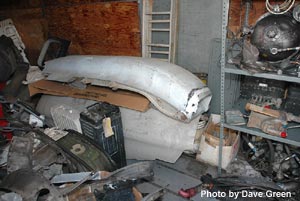 |
 |
 |
| Page Top | Home |
----Created 17 April 2010----